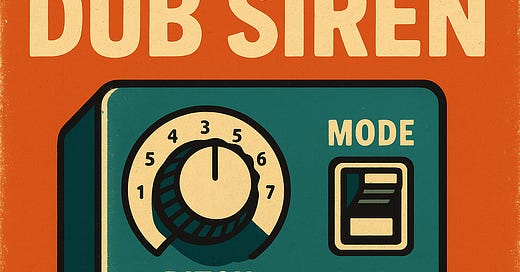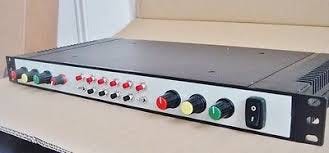Sound of the Dance: The Dub Siren
The Origins of the Dub Siren, Gear, Plugins and How You Can Build Your Own Using Ableton, Logic, or Reaper
The Dub Siren is one of the most iconic sound effects in reggae and dub music.
It's a small device that creates wild, sweeping, often otherworldly sounds that rise, fall, and oscillate—adding energy, tension, and excitement to tracks and live sound system sessions.
Much like delay and reverb, the dub siren became part of the sonic fingerprint of dub music.
But where did it come from? How did it become so important? And why does it still matter today?
During the intro you’ll hear a variety of dub siren fx
What is a Dub Siren?
Simple definition:
A Dub Siren is an electronic sound generator, usually based on a simple oscillator (a device that creates repeating sounds).What it sounds like:
Rising and falling "woo-woo" noises, siren wails, laser zaps, and spacey effects.How it's used:
Triggered during key moments of a track or live performance—between vocal lines, at breakdowns, or during transitions to build hype or add flavor.
History of the Dub Siren
Early sound system culture:
In 1970s Jamaica, sound systems competed by being louder, more exciting, and more innovative than their rivals. DJs, engineers, and toasters wanted new sounds to electrify the crowd.Origins:
The earliest "siren"-type sounds came from real mechanical devices—fire alarms, police sirens, and air raid sirens—which engineers would mic up and run through their sound systems.Electronic innovation:
DIY electronics lovers soon started building small oscillator boxes. These could recreate and control siren sounds using basic circuits: a knob for pitch, a button to trigger the sound, and sometimes switches to change modes (up, down, loop, vibrate).Popularization:
By the late 70s and early 80s, UK sound systems like Jah Shaka, Channel One, and Aba Shanti-I made Dub Sirens a regular feature of their live sessions.
Why the Dub Siren Became So Popular
Attention-grabbing:
A sudden siren blast cuts through a bass-heavy dub mix, grabbing the crowd’s focus immediately.Creating atmosphere:
It adds tension, drama, or excitement without needing vocals or a big musical change.Symbol of the sound:
It became part of the identity of dub and sound system culture. Hearing a siren automatically signals: you're in a dub zone now.
King Tubby’s custom-built mixing consoles (especially his early ones) had a built-in oscillator — basically a simple tone generator. One of the oscillator’s main settings produced a fixed A note (440 Hz or very close to it).
Quick Breakdown:
What it was:
A small tone generator circuit inside his mixer, often built right into the board or routed through it.What it did:
It produced a steady sine wave or a simple tone. This could be used either for:Testing and calibrating the mixer and outboard gear (making sure the signal was strong and clean through the whole system).
Creative effects in dub mixing — Tubby would sometimes dub out the tone itself through delays, reverbs, filters, creating an eerie, otherworldly sound.
Why A note (440 Hz)?
440 Hz is the international standard for tuning musical instruments ("concert pitch").
Having a tone at A made it easy to tune external instruments, test signal paths, or even match FX settings musically.
Real Life Example:
Think about when you hear an old Tubby dub, and suddenly there's a faint pure tone rising or swirling through echoes — that's often his oscillator at work, sent through spring reverb, tape delay, or filters.When Lee 'Scratch' Perry built his Black Ark Studio later, he also used simple oscillators and test tones — but more experimentally (sometimes tuning them off-pitch for psychedelic effect).
Listen to the intro and you’ll hear the test tone fx
How Dub Sirens Are Used Today
Live Sound Systems:
Sound system operators still use handheld sirens, pedal-operated units, or even mobile apps designed to recreate the classic tones.Dub Producers:
Many dub artists sample or record real sirens and blend them into tracks (just like they do with reverb and tape echo).Plugins and Apps:
Digital versions of Dub Sirens are now available, allowing anyone to use sirens in a DAW (music software) with easy controls.DIY Culture:
It's still common for dub lovers to build their own siren boxes, keeping that do-it-yourself spirit alive.
Dub Siren Hardware
BeniDub Dub Siren
Handmade in the UK, famous for authentic analog sounds. Used by many modern sound systems.
Visit SiteCommon Ground Dub Siren
The VCM Dub Siren is a 100% original design that draws inspiration from the classic analog drum synths and embraces the spirit of modular synthesizers
Visit SiteDub Siren
Analog transistor based siren, initially designed for the PA / stadium announcer, it was quickly adopted for reggae sound sytem use from the 70s onwards.Analog transistor based siren, initially designed for the PA / stadium announcer, it was quickly adopted for reggae sound sytem use from the 70s onwards.
Visit The Website
Dub Siren Plugins (Paid)
Akai Ring The Alarm
'Ring The Alarm' resurrects this tradition, offering you an intuitive yet powerful plugin to infuse your tracks with sirens, synth rises, and mashed-up effects.
Free Dub Siren Plugin
nofish Dub Siren
nofish Dub Siren is a monophonic synth aiming to emulate these DIY devices used by Dub Sound Systems.
Free Download
iPhone Dub Siren
(Excellent and loads of options and fun)
The classic dub, reggae app! Enjoy the internet radio stations, or use it as sound effects machine during your DJ set! It has been used by so many DJs in the world.
CREATE YOUR OWN DUB SIREN
1. Ableton Live
Step-by-Step:
Create a MIDI Track
Load Operator (built-in Ableton synth).Oscillator Setup
Set Oscillator A to Sine or Square wave.
Lower the attack for instant sound (fast attack envelope).
Pitch Modulation (LFO)
In Operator, click Pitch Envelope.
Set the envelope to go up and down in pitch.
OR, assign an LFO to pitch:
Drag an LFO from Max4Live tools.
Map it to Operator’s pitch control.
Set the LFO to Triangle or Sine shape.
Adjust Rate (speed) and Depth (how wild it gets).
Add Delay
Load Simple Delay.
Set one side to a slightly different timing than the other (for that stereo dub feel).
Optional:
Add Reverb, Saturator, or Echo to dirty it up.
2. Logic Pro
Step-by-Step:
Create a Software Instrument Track
Load ES2 Synth or Alchemy.Oscillator Setup
In ES2, set Osc 1 to Sine or Square.
Set it to Mono mode (for that single-note trigger).
Pitch Modulation
In the LFO section, choose LFO 1.
Set it to modulate Pitch.
Shape: Triangle or Sine wave.
Adjust Rate (slow = woo-woo; fast = zap-zap).
Add Delay
Load Stereo Delay or Tape Delay.
Short delays (100–300ms) work great.
Add feedback to taste for repeats.
Optional:
Add Space Designer Reverb with a spring setting to simulate dub reverb.
3. Reaper
Step-by-Step:
Create a New Track
Add ReaSynth (comes with Reaper).Oscillator Setup
Set it to Sine wave or Square wave.
Pitch Modulation (LFO)
Insert JS: LFO Generator as a plugin on the track.
Insert JS: MIDI CC to Pitch Bend (optional).
Map LFO to automate pitch bending:
Use Automation Envelopes to create swooping pitch rises and drops.
Add Delay
Insert ReaDelay.
Set a short delay time (about 250ms).
Use stereo settings for wide dub echoes.
Optional:
Add ReaVerb with an impulse response of a spring reverb for extra dub flavor.
Bonus Tips for All DAWs
MIDI Mapping:
Assign knobs/sliders to LFO speed and depth so you can perform live pitch changes like a real dub siren box.Distortion:
Add a tiny bit of distortion to roughen up the siren for a more vintage sound.Automation:
Automate delay feedback and LFO rate for crazy evolving sounds.






Very well written article. I use AmpFreqq 😍
Do you know LA GOLDEN ACAPULCO DUB SIREN? Pretty Dope design
https://www.oficinadesonido.org/la-golden-acapulco-sirena-dub/